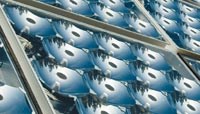Pumping Up Solar Production
Unique finishing process improves CPV manufacturing.
#masking #curing #energy
Whether wind or solar, the alternative energy industry is ramping up production. Many such companies lack finishing expertise and are turning to suppliers of finishing equipment and processes for help in bumping up manufacturing productivity.
Case in point: a California-based supplier of concentrated photovoltaic (CPV) systems. The company worked with Turbo Spray Midwest (Howell, MI) to develop a completely new system for finishing and silvering cells for its systems, which employ curved lenses or mirrors to multiply the sun's power up to 600×. Large arrays of such CPV cells can product gigawatts of power at much higher efficiency than flat-panel solar cells.
Featured Content
Turbo Spray, a 25-year-old supplier of finishing processes and systems for automotive and other applications, had expertise in developing coating application processes and specialty low-pressure liquid application heads. Like many other automotive suppliers, the company was looking for new markets. Alternative energy technology presented an opportunity.
In this case, Turbo Spray's task was to move application techniques for protective and reflecting mirror coatings from single-piece to mass production. The company developed a multi-phase plan to improve CPV cell finishing productivity by evolving finishing from a flow-coating operation to spray application.
Turbo Spray's first tasks were to confirm that the coating materials its customer was using, which were formulated for flow coating, were a viable option for mass production. The company then developed spray application processes for the materials.
Next up was development of a method for presenting parts in the spray zone. The curved glass substrate required special attention to avoid breakage and provide accurate part positioning. High cure temperatures added the element of part expansion/contraction, which had to be accounted for in both tooling design and masking.
Phase three of the project centered on how to apply the proper amount of coating over the complete glass substrate. For this, Turbo Spray chose one of its standard guns, an HVLP spray applicator with fluid recirculation through the fluid tube and analog fan and atomizing air control.
Individual gun fluid flow rates, positions and other process parameters had to be developed and tested until the customer's cycle time requirement was achieved. Film thickness for three coats of paint through the cured surface was held to 1 ± 0.2 mils.
Next up was development of a cure cycle for the parts. Turbo Spray determined that electric infrared curing would be most cost-effective, but the concave part shape and customer requirements for no blistering or browning presented challenges. The solution was based on IR fixture style and orientation, plus power ramping in multiple oven zones and part placement inside the oven.
For the final line design, Turbo Spray chose a floor-mounted chain-on-edge system, which could smoothly accelerate, decelerate and stop the fragile parts and withstand heat fluctuations. Other system attributes include:
- Consistent start/stop positions in multiple spray zones
- Consistent coating delivery and temperature
- Consistent and controllable part rotation speeds
- Energy efficiency
- High transfer efficiency using true low-pressure atomizing (8 psi)
- PLC controls with remote operator interface panel
- Small overall machine footprint.
The CPV system supplier has recently installed Turbo Spray's processes for silvering one surface of the mirrors and for applying a protective coating to the other side. Production volumes using the new systems ramped up from one mirror per minute to 5 mirrors per minute. Transfer efficiencies on the difficult part configuration are 80%.
RELATED CONTENT
-
Understanding Paint Atomization
BASF coatings development expert Tim December explains how paint atomization works for both pneumatic spray applicators and high-speed rotary bell applicators.
-
Paint Application Methods
An overview of spraying, dipping, flow coating, and everything in between.
-
Phosphate Conversion Coatings
Types of phosphate conversion coatings, how to apply them, and their specific functions.




















